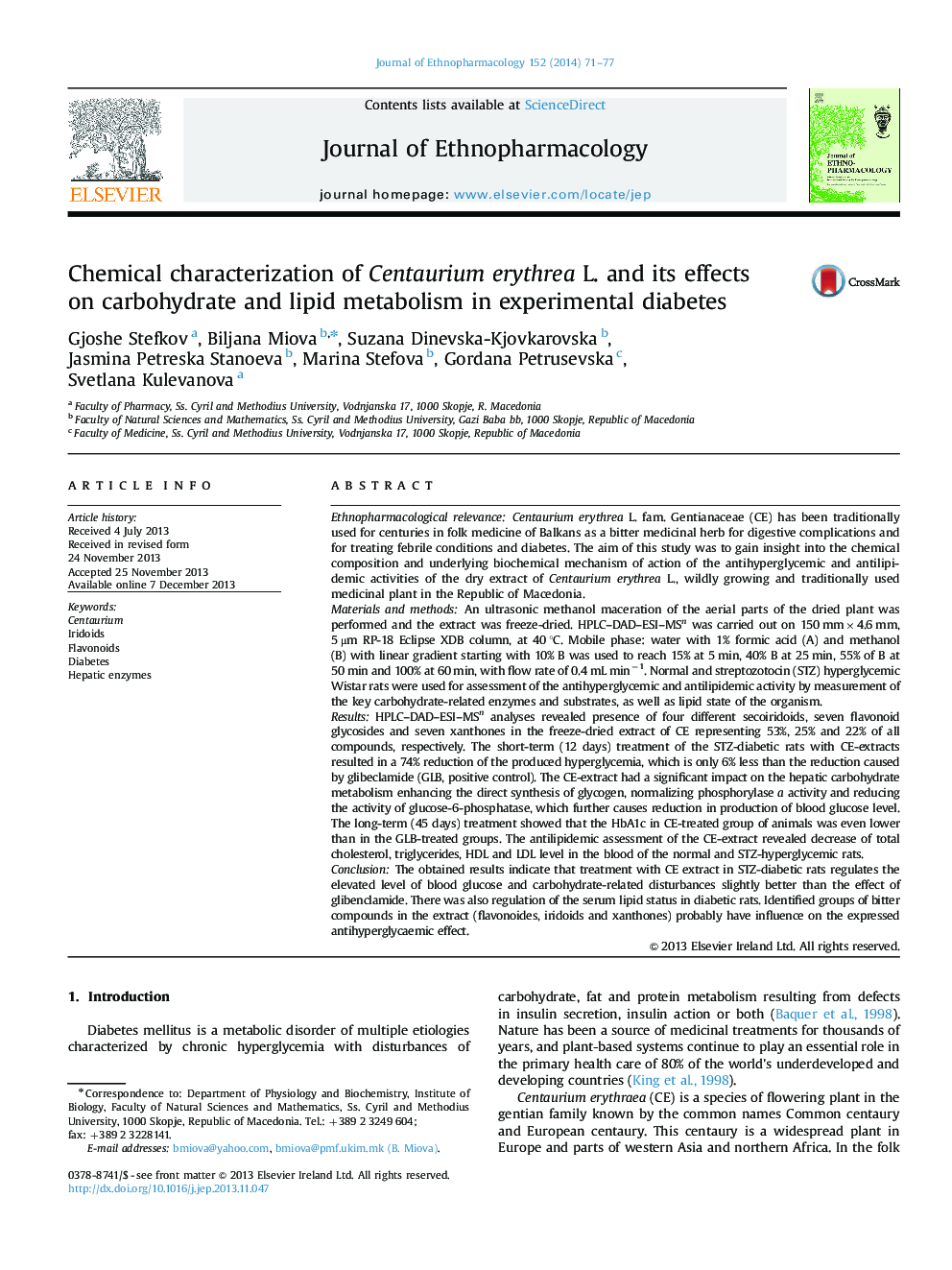| کد مقاله | کد نشریه | سال انتشار | مقاله انگلیسی | نسخه تمام متن |
|---|---|---|---|---|
| 2545211 | 1123941 | 2014 | 7 صفحه PDF | دانلود رایگان |

Ethnopharmacological relevanceCentaurium erythrea L. fam. Gentianaceae (CE) has been traditionally used for centuries in folk medicine of Balkans as a bitter medicinal herb for digestive complications and for treating febrile conditions and diabetes. The aim of this study was to gain insight into the chemical composition and underlying biochemical mechanism of action of the antihyperglycemic and antilipidemic activities of the dry extract of Centaurium erythrea L., wildly growing and traditionally used medicinal plant in the Republic of Macedonia.Materials and methodsAn ultrasonic methanol maceration of the aerial parts of the dried plant was performed and the extract was freeze-dried. HPLC–DAD–ESI–MSn was carried out on 150 mm×4.6 mm, 5 μm RP-18 Eclipse XDB column, at 40 °C. Mobile phase: water with 1% formic acid (A) and methanol (B) with linear gradient starting with 10% B was used to reach 15% at 5 min, 40% B at 25 min, 55% of B at 50 min and 100% at 60 min, with flow rate of 0.4 mL min−1. Normal and streptozotocin (STZ) hyperglycemic Wistar rats were used for assessment of the antihyperglycemic and antilipidemic activity by measurement of the key carbohydrate-related enzymes and substrates, as well as lipid state of the organism.ResultsHPLC–DAD–ESI–MSn analyses revealed presence of four different secoiridoids, seven flavonoid glycosides and seven xanthones in the freeze-dried extract of CE representing 53%, 25% and 22% of all compounds, respectively. The short-term (12 days) treatment of the STZ-diabetic rats with CE-extracts resulted in a 74% reduction of the produced hyperglycemia, which is only 6% less than the reduction caused by glibeclamide (GLB, positive control). The CE-extract had a significant impact on the hepatic carbohydrate metabolism enhancing the direct synthesis of glycogen, normalizing phosphorylase a activity and reducing the activity of glucose-6-phosphatase, which further causes reduction in production of blood glucose level. The long-term (45 days) treatment showed that the HbA1c in CE-treated group of animals was even lower than in the GLB-treated groups. The antilipidemic assessment of the CE-extract revealed decrease of total cholesterol, triglycerides, HDL and LDL level in the blood of the normal and STZ-hyperglycemic rats.ConclusionThe obtained results indicate that treatment with CE extract in STZ-diabetic rats regulates the elevated level of blood glucose and carbohydrate-related disturbances slightly better than the effect of glibenclamide. There was also regulation of the serum lipid status in diabetic rats. Identified groups of bitter compounds in the extract (flavonoides, iridoids and xanthones) probably have influence on the expressed antihyperglycaemic effect.
Figure optionsDownload high-quality image (94 K)Download as PowerPoint slide
Journal: Journal of Ethnopharmacology - Volume 152, Issue 1, 27 February 2014, Pages 71–77